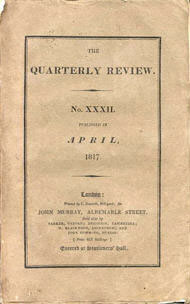Early years
Initially, the Quarterly was set up primarily to counter the influence on public opinion of the Edinburgh Review . Its first editor, William Gifford, was appointed by George Canning, at the time Foreign Secretary, later Prime Minister.
Early contributors included Secretaries of the Admiralty John Wilson Croker and Sir John Barrow, Poet Laureate Robert Southey, poet-novelist Sir Walter Scott, Italian exile Ugo Foscolo, Gothic novelist Charles Robert Maturin, and the essayist Charles Lamb.
Under Gifford, the journal took the Canningite liberal-conservative position on matters of domestic and foreign policy, if only inconsistently. [3] It opposed major political reforms, but it supported the gradual abolition of slavery, moderate law reform, humanitarian treatment of criminals and the insane, and the liberalizing of trade. In a series of articles in its pages, Southey advocated a progressive philosophy of social reform. Because two of his key writers, Scott and Southey, were opposed to Catholic emancipation, Gifford did not permit the journal to take a clear position on that issue.
Reflecting divisions in the Conservative party itself, under its third editor, John Gibson Lockhart, the Quarterly became less consistent in its political philosophy. While Croker continued to represent the Canningites and Peelites, the party's liberal wing, it also found a place for the more extremely conservative views of Lords Eldon and Wellington.
During its early years, reviews of new works were sometimes remarkably long. That of Henry Koster's Travels in Brazil (1816) ran to forty-three pages. [4]
Controversial reviews
Typical of early nineteenth-century journals, reviewing in the Quarterly was highly politicized and on occasion excessively dismissive. Writers and publishers known for their Unitarian or radical views were among the early journal's main targets. Prominent victims of scathing reviews included Irish novelist Lady Morgan (Sydney Owenson), English poet and essayist Walter Savage Landor, as well as English novelist Mary Wollstonecraft Shelley and her husband Percy Bysshe Shelley.
In an 1817 article, John Wilson Croker attacked John Keats in a review of Endymion for his association with Leigh Hunt and the so-called Cockney School of poetry. Shelley blamed Croker's article for bringing about the death of the seriously ill poet, 'snuffed out', in Byron's ironic phrase, 'by an article'.
In 1816, Sir Walter Scott reviewed his own, but anonymously published, Tales of My Landlord, partly to deflect suspicion that he was the author; he proved one of the book's harshest critics. Scott was also the author of a favourable review of Jane Austen's Emma .
This page is based on this
Wikipedia article Text is available under the
CC BY-SA 4.0 license; additional terms may apply.
Images, videos and audio are available under their respective licenses.
